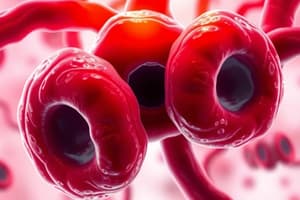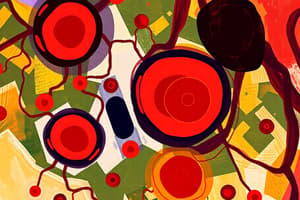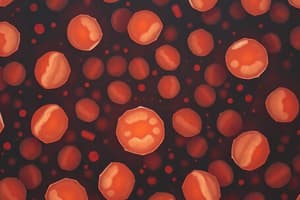Podcast
Questions and Answers
What is the primary role of red blood cells in the body?
What is the primary role of red blood cells in the body?
- Transporting nutrients
- Carrying oxygen to tissues (correct)
- Clotting blood
- Fighting infections
Which process describes the formation of red blood cells?
Which process describes the formation of red blood cells?
- Thrombopoiesis
- Erythropoiesis (correct)
- Leukopoiesis
- Hematogenesis
What condition is characterized by a deficiency of hemoglobin?
What condition is characterized by a deficiency of hemoglobin?
- Leukemia
- Thrombocytopenia
- Hyperlipidemia
- Anemia (correct)
Which of the following is a mechanism involved in blood clotting?
Which of the following is a mechanism involved in blood clotting?
What is the liquid component of blood known as?
What is the liquid component of blood known as?
Which disease is primarily associated with bleeding disorders?
Which disease is primarily associated with bleeding disorders?
What laboratory technique is useful for analyzing blood cell types?
What laboratory technique is useful for analyzing blood cell types?
The process of differentiation and maturation of blood cells is referred to as?
The process of differentiation and maturation of blood cells is referred to as?
What is the primary function of red blood cells?
What is the primary function of red blood cells?
Which component of blood is primarily involved in blood clotting?
Which component of blood is primarily involved in blood clotting?
What is hemoglobin primarily responsible for in red blood cells?
What is hemoglobin primarily responsible for in red blood cells?
Which of the following is NOT a component of blood?
Which of the following is NOT a component of blood?
What is the role of electrolytes in blood?
What is the role of electrolytes in blood?
Which of the following accurately describes the composition of plasma?
Which of the following accurately describes the composition of plasma?
Which type of white blood cells are primarily involved in the immune response?
Which type of white blood cells are primarily involved in the immune response?
How does blood contribute to homeostasis in the body?
How does blood contribute to homeostasis in the body?
What is the normal range for total white blood cell count?
What is the normal range for total white blood cell count?
What percentage of lymphocytes is typically found in the differential white blood cell count?
What percentage of lymphocytes is typically found in the differential white blood cell count?
What is the primary function of hemoglobin in red blood cells?
What is the primary function of hemoglobin in red blood cells?
Which of the following electrolytes is measured in milliequivalents per liter (mEq/L)?
Which of the following electrolytes is measured in milliequivalents per liter (mEq/L)?
Which component of blood is primarily involved in the process of blood clotting?
Which component of blood is primarily involved in the process of blood clotting?
What is the primary function of plasma proteins such as albumin?
What is the primary function of plasma proteins such as albumin?
What is the typical range for platelet count?
What is the typical range for platelet count?
Which of the following nutrients is NOT typically transported by blood?
Which of the following nutrients is NOT typically transported by blood?
Flashcards
What is Hematology?
What is Hematology?
The branch of medicine that focuses on the study of blood, blood-forming tissues, and their related disorders.
What is the function of blood?
What is the function of blood?
Blood is a vital fluid that circulates throughout the body, carrying oxygen, nutrients, and removing waste products. It is composed of several components.
What is Plasma?
What is Plasma?
The liquid component of blood, making up about 55% of total blood volume. It contains water, proteins, electrolytes, and other substances.
What is Hematopoiesis?
What is Hematopoiesis?
Signup and view all the flashcards
What are Hematopoietic Stem Cells?
What are Hematopoietic Stem Cells?
Signup and view all the flashcards
What is Erythropoiesis?
What is Erythropoiesis?
Signup and view all the flashcards
What is Leukopoiesis?
What is Leukopoiesis?
Signup and view all the flashcards
What is Thrombopoiesis?
What is Thrombopoiesis?
Signup and view all the flashcards
What is the primary function of red blood cells?
What is the primary function of red blood cells?
Signup and view all the flashcards
What is the role of white blood cells?
What is the role of white blood cells?
Signup and view all the flashcards
What are platelets responsible for?
What are platelets responsible for?
Signup and view all the flashcards
How are hormones transported through the body?
How are hormones transported through the body?
Signup and view all the flashcards
What role do nutrients play in blood?
What role do nutrients play in blood?
Signup and view all the flashcards
What is the importance of electrolytes in blood?
What is the importance of electrolytes in blood?
Signup and view all the flashcards
How does blood get rid of waste products?
How does blood get rid of waste products?
Signup and view all the flashcards
What are platelets?
What are platelets?
Signup and view all the flashcards
What is hemoglobin?
What is hemoglobin?
Signup and view all the flashcards
What are leukocytes?
What are leukocytes?
Signup and view all the flashcards
Study Notes
Introduction to Hematology
- Hematology is the study of blood, blood-forming tissues, and related disorders
- It involves examining blood cells (red blood cells, white blood cells, platelets), blood components, and blood clotting mechanisms (hemostasis)
- Hematologists diagnose and treat blood-related conditions like anemia, leukemia, lymphoma, and bleeding disorders
Course Outlines
- Hematology courses cover blood and blood-forming tissues, including structure, function, and disorders
- Course content varies by educational level (undergraduate, graduate, or professional) and institution's curriculum
Introduction to Hematology
- Review of blood components (red blood cells, white blood cells, platelets) and their functions
- Functions of blood in the body
Blood Cell Formation (Hematopoiesis)
- Hematopoietic stem cells are involved
- Differentiation and maturation of blood cells into specific types (erythropoiesis, leukopoiesis, and thrombopoiesis)
Hemoglobin and Hematocrit
- Structure and function of hemoglobin
- Measurement of hematocrit levels
Hemostasis and Coagulation
- Mechanisms of blood clotting
- Coagulation cascade
- Disorders of hemostasis
Blood Related Diseases
- Anemias (iron-deficiency anemia, hemolytic anemia)
- Leukemias and lymphomas
- Thrombocytopenia and other platelet disorders
Diagnostic Techniques
- Bone marrow aspiration and biopsy
- Blood transfusions
Hemostasis Disorders
- Hemophilia
- von Willebrand disease
- Disseminated intravascular coagulation (DIC)
Laboratory Techniques
- Blood cell counts
- Hemoglobin measurement
- Coagulation tests
Composition of Blood
- Blood is a complex fluid with various components
- Plasma is the liquid component, making up about 55% of blood volume
- Plasma contains water, electrolytes, proteins, hormones, waste products, and gases, and plays a vital role in transporting nutrients, hormones, and waste products
Red Blood Cells (Erythrocytes)
- Most abundant blood cells
- Transport oxygen from the lungs to tissues and carry carbon dioxide back to the lungs for removal
- Contain hemoglobin, a protein that binds with oxygen molecules
White Blood Cells (Leukocytes)
- Crucial components of the immune system
- Defend against infections and foreign substances
- Different types of white blood cells include neutrophils, lymphocytes, monocytes, eosinophils, and basophils
Platelets (Thrombocytes)
- Small cell fragments involved in blood clotting
- Prevent excessive bleeding by forming clots at sites of blood vessel injuries
Hormones
- Blood transports hormones produced by endocrine glands to target organs
- Regulates processes like metabolism, growth, and reproduction
Nutrients
- Blood carries nutrients like glucose, amino acids, and fatty acids to cells
- Essential for energy production and cellular functions
Electrolytes
- Essential for maintaining fluid balance, nerve, and muscle function
- Examples: sodium, potassium, calcium, and chloride
Waste Products
- Blood transports waste products (CO2, urea) to organs like lungs and kidneys for removal
Concentration of Blood Components
- Red blood cells (erythrocytes): normal range, hemoglobin concentration
- White blood cells (leukocytes): total count, differential count (neutrophils, lymphocytes, monocytes, eosinophils, basophils)
- Platelets (thrombocytes): typical count
- Plasma: water content, typical plasma protein levels (albumin, globulins, fibrinogen)
Electrolytes (Concentrations)
- Sodium (Na+)
- Potassium (K+)
- Calcium (Ca2+)
- Chloride (Cl-)
- Bicarbonate (HCO3-)
Gases (Oxygen and Carbon Dioxide)
- Concentrations vary based on factors like respiratory status
Functions of Blood
- Oxygen and Carbon Dioxide transport
- Nutrient transport
- Hormone transport
- Immune response
- Blood clotting (hemostasis)
- Maintenance of pH and electrolyte balance
- Temperature regulation
- Waste removal
Blood Volume Regulation
- Blood pressure and volume are maintained through mechanisms such as vasoconstriction and vasodilation
Homeostasis
- Blood plays a crucial role in maintaining the body's internal environment, ensuring optimal functioning of physiological processes
Studying That Suits You
Use AI to generate personalized quizzes and flashcards to suit your learning preferences.




